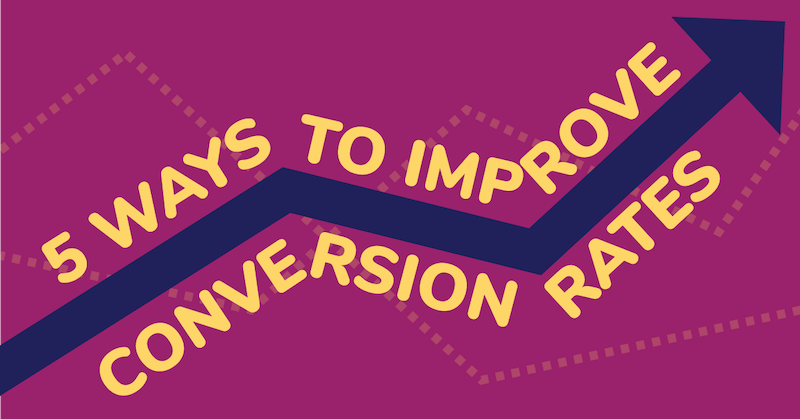Five ways to improve conversion rates

Every advertising campaign is unique and has its own set of challenges and goals. But ultimately, every campaign is chasing the same thing: conversions. Whether you’re hoping for clicks, form fills, or completed purchases, conversions drive every strategic choice you make. When rates are low, it can be discouraging. It can feel like a mystery lockbox, and you don’t have the key to unlock success. However, improving your conversion rates doesn’t have to be a mystery. You may not have the one key that will unlock the highest rates, but you can certainly use a master key first! Here in this list, we’ve put together just such a master key for you. Here are five ways to improve conversion rates.

1. Showcase customer reviews.
Improving your conversion rates doesn’t just depend on the contents of your ads or your website. The vast majority of consumers – 89%, according to one study – take online reviews into consideration when deciding whether to make a purchase. So, make it easy for your audience to see those reviews! Link to online review sites such as Yelp and Google. Or, even better, select some reviews to highlight right on your website, in addition to linking to the third-party sites. The on-site reviews will be enough for many people to be convinced. The off-site links will make it easier for those who need more convincing to get the proof they need.

2. Conduct A/B tests.
We’ve already covered the basics of A/B testing in our articles (part one, part two) but as a reminder: A/B tests involve running two different versions of a campaign simultaneously, and they were designed with improving conversion rates in mind. The whole point of an A/B test is to try out different things to see which one moves the needle more. Of course, it costs a little more to create and run two different versions of a campaign, so if you don’t have the budget to back it up, this may not be the solution for you. But if you do have the money to run a test, you’ll be rewarded with data-backed results you can use to guide your marketing efforts towards higher conversion rates.

3. Optimize your site for mobile.
Let’s face it: the days of assuming that everyone who views your site will be using a desktop or laptop computer are over. When was the last time you met someone who didn’t use a smartphone? Times have changed, and if you’re not considering mobile when building your site, you’re ignoring the experience of a huge portion of your audience. But what does that have to do with conversions? Quite simply: everything. A delay of just one second in mobile page load time can result in a 7% decrease in conversions. A whopping 40% of users abandon any site that takes longer than 3 seconds to load. I’m sure that rings true to your own experience of frustration with slow-loading pages. The golden rule applies here: if you wouldn’t want to experience it yourself, make sure your audience doesn’t have to either! Use Google’s PageSpeed tools, keep your image file sizes down, and make sure your page is responsive and optimized for mobile users.
4. Remove friction.
Like we said above, every campaign is unique in the exact goals it’s trying to achieve. But at the heart of every campaign, there should also be this goal: make things as easy for your potential customers as possible. So comb through the steps in the life cycle of your campaign with that in mind. Or, better yet, have people test your campaign for you. What are the pain points? Is anything confusing? Are there too many unnecessary steps? The more friction a customer feels, the more likely they are to click away. If they click on an ad that displays a particular product, but it takes them to your homepage instead of the product…they’re likely to get annoyed. (You may want them to browse through your entire site, but that’s not what they clicked on the ad for.) You want the customer journey to be a smooth one. Any aspect of your campaign that isn’t as straightforward as it could be, or presents frustrations, needs a serious rethink.
We recommend taking this step even further and encourage you to remove all extra elements from your ads and landing pages. People are easily distracted! If your page contains too many elements fighting for their attention, they’re less likely to follow your desired conversion path. For more information on this, check out our deep dive into the importance of landing pages.

5. Bring shoppers back with an abandoned cart campaign.
Removing friction for customers is very effective, but it can seem a little bit theoretical. If you’re looking for a quick way to improve conversion rates directly, consider running an abandoned cart campaign. These campaigns send reminders and/or coupons to users who have visited your site, added something to their shopping cart, but haven’t checked out. If you run an e-commerce site and you’re not running a campaign like this, you could be missing out on a serious slice of the conversion pie: in 2019, the average cart abandonment rate was 77% (a number even higher on mobile devices)! These campaigns are a great, low-risk way to increase your conversion rates because you know the audience is already interested in your product. After all, they’ve already gone to the trouble of visiting your site, finding a product they like, and adding it to their cart. Sometimes all they need is a little nudge to complete that last step.
As you can see, if you’re struggling with low conversion rates, you have plenty of options! From the theoretical to the straightforward, these five ways to improve your conversion rates are a great place to start if you’re looking to increase campaign performance.


